- The destruction wrought by Covid-19 has also opened up the opportunity to deliver economic recovery through energy that is green, clean, resilient and inclusive.
- With this in mind, South Africa’s energy and policy researchers are pondering how the country can transition to a sustainable smart energy system with waste-to-energy (WtE) as a resource, writes the CEO of the South African National Energy Development Institute (SANEDI), Dr Zwanani Titus Mathe.
According to the World Bank, just over 2 billion tonnes of municipal solid waste were disposed in world cities in 2016, a figure that is expected to increase to 3.4 billion tonnes by 2050. Moreover, it is estimated that waste generation rates will more than double over the next 20 years in lower-income countries, especially in Africa.
Over 70% of South Africa’s waste currently goes to landfill, resulting in a loss of resources to the economy and serious human health and environmental impacts. A 2017 study concluded that the waste sector contributes to more than 4% of the national GHG emissions. At the same time, South Africa is seeing a large-scale shift towards low-carbon energy sources and solutions, while continuing the drive for universal energy access to help accelerate poverty alleviation in the country.
Despite all these drivers, none of the country’s existing national or local level policies explore the opportunities that lie at the intersection of waste, climate change and renewable energy provision.
Responding to this gap, SANEDI, in partnership with the Department of Science and Innovation (DSI), National Research Foundation (NRF) and Council for Scientific and Industrial Research (CSIR) South African Research Chair in Waste and Climate Change at the CSIR and University of KwaZulu-Natal, has been developing a Waste-to-Energy (WtE) Roadmap for South Africa with the aim to chart the potential for inserting waste-to-energy technology options into municipal planning.
The WtE opportunities at municipal level are numerous and compelling. Depending on the technology employed, municipal solid waste (MSW) and other waste types can be processed to produce biogas, biofuels, synthetic gas or bio-oil, all of which have applications in electricity generation, heating or as fuel for vehicles. In all instances, fossil fuels are replaced and greenhouse gas emissions avoided. Of at least equal importance is the economic and job creation potential of the waste-to-energy sector. Developing and operating processing facilities require skilled labour, engineering expertise and maintenance services. In addition, the production of energy from waste contributes to energy security, reduce waste-management costs and create revenue streams through the sale of electricity, heat or biofuels.
The primary motivation behind the development of the WtE Roadmap is the lack of a specific institutional framework for guiding the various governmental sectors and decision makers in the successful implementation of the waste-to-energy sector in South Africa. While the country has many position papers and policy proposals for WtE, they tend to contradict waste and energy institutional frameworks, which makes successful implementation virtually impossible. For instance, the Municipal Finance Management Act limits contract terms to three years, whereas some off-takers require 10-to-15-year commitments in order to become financially viable. The latter requires a Section 21A process.
In addition to overarching policy frameworks, municipalities also need decision-making tools to help them select the WtE strategy that best achieves sustained waste reduction, resource recovery, carbon emissions reduction and job creation in their particular community. Currently, landfilling is still seen as the best solution due to the ease of disposal and the low gate fees. In the absence of full-cost accounting methodologies, this barrier will continue to deter WtE energy projects as the solution for waste disposal.
Solving two of the world’s greatest challenges – waste and energy – in one solution is no longer a pipedream thanks to rapidly developing WtE technologies. Not surprising that waste valorisation, which is the process of extracting value or useful resources from waste materials rather than simply disposing of them, is gaining traction around the world. The goal of valorisation is to reduce waste, conserve resources and create economic opportunities – a trifecta of objectives that almost all societies sorely need to meet.
However, despite WtE technologies maturing, implementation is slow. In South Africa, we have the National Waste Management Strategy (2020), which focuses on long-term waste management practices, and the National Biogas Strategy, which presents a set of guidelines for the insertion of biogas-to-energy projects. However, we still need a specific WtE management framework, developed in consultation with all levels of government and relevant stakeholders through an open and deliberated process.
Simply put, the principles at play are understood and largely agreed upon, but the nuts and bolts remain unresolved. South Africa needs a focused and detailed WtE policy, along with clarity on matters such as plant size, minimum waste-material volumes and the costs and timelines involved in meeting licensing requirements.
Without it, developers will remain understandably uncomfortable to commit to waste-to-energy plants in South African municipalities, condemning public-sector WtE to a metaphorical landfill.
Source: SANEDI















